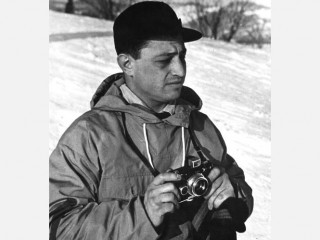
Carl Mydans biography
Date of birth : 1907-05-20
Date of death : 2004-08-16
Birthplace : Boston, Massachusetts, United States
Nationality : American
Category : Famous Figures
Last modified : 2011-01-27
Credited as : Photographer, journalist, Life magazine
Carl Mydans was an American photojournalist. He worked briefly for the Farm Security Administration during the 1930s documenting rural American life. In 1936 he joined the newly formed LIFE magazine where he became well known for his photographic coverage of World War II. He continued as a war photographer through the early 1970s.
Carl Mydans was born in Boston on May 20, 1907. The family moved to Medford, Massachusetts, on the Mystic River where Carl went to high school and worked in the local boatyards after school and on weekends. He later became interested in journalism and worked as a free-lance reporter for several local newspapers. In 1930 he graduated from the Boston University School of Journalism.
Mydans then moved to New York and, while working as a reporter for the "American Banker," began to study photography at the Brooklyn Institute of Arts and Sciences. In July 1935 his skill with the new 35mm "miniature" camera landed him a job with the Department of the Interior's Resettlement Administration, which soon merged into the Farm Security Administration (FSA). Mydans joined Walker Evans and Arthur Rothstein as the core of the remarkable team of photographers assembled by Roy Stryker to document rural America.
While travelling through the southern states photographing everything that had to do with cotton, Mydans developed the shooting style he would use throughout his career. He concentrated on people, and he photographed them in a respectful and straightforward manner. As he had been taught to do as a reporter, he kept careful notes on every shot.
When Mydans joined the staff of Life in 1936 he joined a group of photojournalists who were changing the way press photography was done. Photojournalists had traditionally used 4x5 Speed Graphic cameras with flashguns and reflector pans, and their pictures of people tended to look much the same: overlit foregrounds fell off to dark backdrops that had no detail. But Mydans and his colleagues at Life relied on 35mm cameras that allowed them to work with available light, capturing a new kind of excitement and activity in their photographs. Their success with the small camera revolutionized the practice of photojournalism.
In 1938 Mydans went overseas with his wife, Life reporter Shelley Mydans, and began his long career as a war photographer. During the next 30 years he covered conflicts in Europe, the Far East, and Southeast Asia. In World War II he was a prisoner of the Japanese for 21 months. Always, he focussed his camera on the small human drama that revealed the larger story. He retired from Life in 1972 but continued to work for Time and other magazines.
Carl Mydan's work has been displayed in various galleries throughout the United States. The New York Times Magazine featured his work, along with Alfred Eisenstaedt's and Joe Rosenthal's in May of 1995.
Mydans called himself a "story-teller with pictures" and always maintained that he did not photograph war because he liked it, but because he thought it was important to make an historic record of his times. "Long after I am gone," he said, "I want people to be able to see and especially feel what I have seen and felt."
Mydan's autobiography, More Than Meets the Eye (1959; Carl Mydans: Photojournalist (1985).
















